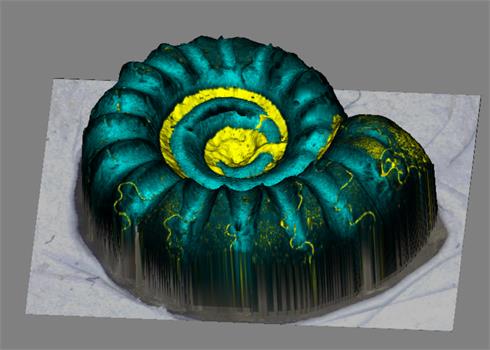Far from extinct - Raman imaging of ammonite fossils
29 July 2020
There is very little in this world which evokes the imagination in the same way as prehistoric life. As a young boy holidaying at Lyme Regis in the south of England, the now world heritage Jurassic fossil site, finding fossils wasn't just something to do to pass the time, it was exciting and completely captivating. It is a link to a different world. A real world which existed exactly where we are but so long ago as to be almost incomprehensible.
Of course, Raman imaging has long been an established technique to determine the composition of inorganics and minerals within geological sections. Showing the specificity to differentiate between material polytypes. Over the years, Raman imaging has become faster, enabling improved context and representation of larger samples. More recent additions of focus tracking capabilities (such as Renishaw's LiveTrack™) now enable complex surface topographies to be accurately analysed. It is now possible to analyse mineralogy and palaeontology samples without having to section and polish them, helping to reveal more detail about the native material properties.
Analysing ammonites
Here I use StreamLineTM Raman imaging with LiveTrack to analyse an ammonite fossil originating from Lyme Regis (Black Ven). Ammonites are a group of extinct molluscs. While appearing to have a form similar to shelled nautiloids, they are actually more closely related to coleoids such as squid and octopuses. Their characteristic shape has given them the nickname of ‘snake stones'. To the well-trained eye of a fossil hunter, they are instantly recognisable within the vast array of rocks and pebbles.
I was able to collect over 1 million spectra from the sample. The different materials were identified from the StreamLine Raman data, and chemical images generated in conjunction with WiRE software masking. These show fossil and surrounding material to comprise of iron sulfide, and calcium carbonate. As well as showing detailed images of the different materials present, subtle changes in crystallinity and stress are also revealed. These are seen against the context of the 3D topographical image, where iron sulfide crystallinity and stress properties correlate specifically to the topographical features (septa). Low iron sulfide crystallinity correlates to the peaks of the septa and varies in range by 3.5 cm-1 (341 cm‑1 band). Compressive iron sulfide stresses correlate to the edges of the septa peaks (the regions of maximum septa curvature) and vary in range from 339.11 cm-1 to 343.10 cm-1.
It is typical for ammonites to have suture patterns on their shells. The patterns consist of three main types, correlating to the time period during which they lived. Here we show that these patterns produce increased optical fluorescence correlating with the presence of calcium carbonate. This enables enhanced contrast relative to the white light image.
The detailed chemical and property information shows the value of Raman data in understanding real world samples without sample preparation. Viewing this against the context of the surface topography, enabled with Renishaw's LiveTrack technology, provides an incredible recreation of the material.
Next time you are at the beach, think about the hidden fossils which might be beneath your very feet, and the detailed studies which can be performed using Renishaw's Raman equipment!
3D Raman imaging of ammonite
About the author
Tim Smith, Applications Manager

Tim has over 20 year's experience using a range of Raman research instruments. He has extensive knowledge and real-world use of systems in most application areas, however his particular expertise is within Raman imaging and pharmaceutical applications.
Tim spearheaded the application of StreamLine imaging in 2007 to large scale high resolution chemical imaging. His more recent emphasis has been on live focus tracking of materials and correlative chemical and morphological imaging.

